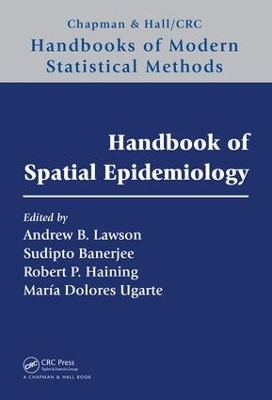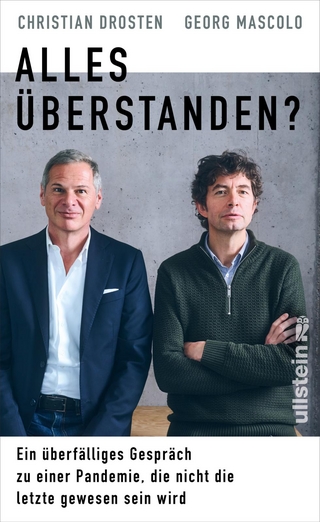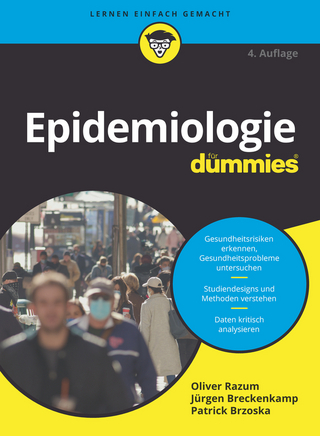
Handbook of Spatial Epidemiology
Chapman & Hall/CRC (Verlag)
978-1-4822-5301-6 (ISBN)
The first part of the book addresses general issues related to epidemiology, GIS, environmental studies, clustering, and ecological analysis. The second part presents basic statistical methods used in spatial epidemiology, including fundamental likelihood principles, Bayesian methods, and testing and nonparametric approaches. With a focus on special methods, the third part describes geostatistical models, splines, quantile regression, focused clustering, mixtures, multivariate methods, and much more. The final part examines special problems and application areas, such as residential history analysis, segregation, health services research, health surveys, infectious disease, veterinary topics, and health surveillance and clustering.
Spatial epidemiology, also known as disease mapping, studies the geographical or spatial distribution of health outcomes. This handbook offers a wide-ranging overview of state-of-the-art approaches to determine the relationships between health and various risk factors, empowering researchers and policy makers to tackle public health problems.
Andrew B. Lawson is a professor of biostatistics in the Division of Biostatistics, Department of Public Health Sciences, College of Medicine at the Medical University of South Carolina (MUSC). He is an MUSC eminent scholar and American Statistical Association (ASA) fellow. He is also an advisor in disease mapping and risk assessment for the World Health Organization, the founding editor of the journal Spatial and Spatio-Temporal Epidemiology, and the author of eight books, including the highly regarded Chapman & Hall/CRC book Bayesian Disease Mapping: Hierarchical Modeling in Spatial Epidemiology, Second Edition. He has published more than 150 journal articles on spatial epidemiology, spatial statistics, and related areas. He earned a PhD in spatial statistics from the University of St. Andrews. Sudipto Banerjee is a professor and chair in the Department of Biostatistics at the University of California, Los Angeles. He is an elected fellow of the ASA, the Institute of Mathematical Statistics, and the International Statistical Institute. He is also a recipient of the Mortimer Spiegelman Award from the American Public Health Association. He is the author/coauthor of more than 100 peer-reviewed publications and two highly regarded Chapman & Hall/CRC books: Hierarchical Modeling and Analysis for Spatial Data, Second Edition and Linear Algebra and Matrix Analysis for Statistics. His research interests include hierarchical modeling and Bayesian inference for spatially referenced data. Robert Haining retired as a professor of human geography from the University of Cambridge in September 2015. He is the author/coauthor of more than 150 articles and two books. His research focuses on the quantitative analysis of geographical data, including the geography of health, spatial representation, spatial sampling, exploratory data analysis, small-area estimation and hypothesis testing, spatial data analysis, and spatial econometrics. His past work has involved the evaluation of the impact of air pollution on health status using small-area statistics as well as the development of new methods for evaluating the effectiveness of small-area targeted police interventions. María Dolores Ugarte is a professor of statistics at the Public University of Navarre. She is the author/coauthor of many papers on statistics and epidemiology and several books, including the recent Chapman & Hall/CRC book Probability and Statistics with R, Second Edition. She is also an associate editor for Statistical Modelling, TEST, and Computational Statistics and Data Analysis as well as an editorial panel member of Spatial and Spatio-Temporal Epidemiology. Her research focuses on spatiotemporal disease mapping and small-area estimation with applications in several fields. She earned a PhD in statistics from the Public University of Navarre.
Introduction. Basic Methods. Special Methods. Special Problems and Applications. Index.
| Erscheinungsdatum | 30.07.2016 |
|---|---|
| Reihe/Serie | Chapman & Hall/CRC Handbooks of Modern Statistical Methods |
| Zusatzinfo | 28 Tables, black and white; 129 Illustrations, black and white |
| Sprache | englisch |
| Maße | 178 x 254 mm |
| Gewicht | 1406 g |
| Themenwelt | Mathematik / Informatik ► Mathematik |
| Studium ► Querschnittsbereiche ► Epidemiologie / Med. Biometrie | |
| ISBN-10 | 1-4822-5301-1 / 1482253011 |
| ISBN-13 | 978-1-4822-5301-6 / 9781482253016 |
| Zustand | Neuware |
| Haben Sie eine Frage zum Produkt? |
aus dem Bereich


